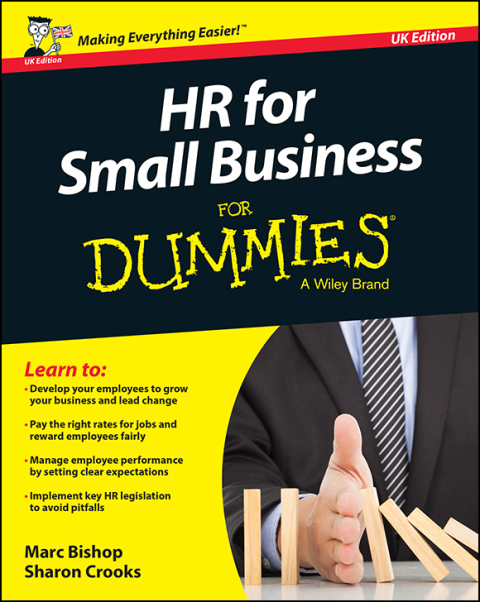Description
Efnisyfirlit
- Cover
- Introduction
- About This Book
- Foolish Assumptions
- Icons Used In This Book
- Beyond The Book
- Where To Go From Here
- Part I: Getting Started with HR
- Chapter 1: Getting into the Business of People
- Becoming an Employer
- Managing People, Pay and Rations
- Growing People as Your Business Grows
- Losing People without Losing Business, Money or Face
- Chapter 2: Recruiting Your First People
- Knowing Your Business Model and Business Plan
- Assessing What Skills and Experience Your Business Needs
- Attracting the Right People
- Dealing with the Candidates
- Selecting the Right People
- Making a Job Offer
- Chapter 3: Working Together
- Getting The Practicalities Right
- Setting the Culture and Values of Your Business
- Managing People
- Chapter 4: Managing Your Pay and Benefits
- Understanding Reward Management
- Working with the Minimum Wage
- Living with the Living Wage
- Accounting for Pension Provision
- Coughing Up SSP and Other Medical Payments
- Claiming Financial Help with Statutory Payments
- Exploring Different Approaches to Pay
- Understanding Benefits
- Saying Thank You Goes a Long Way
- Chapter 5: Parting Company
- Keeping the Right People in Your Business
- Firing People Fairly
- Getting It Right: Best Practice for Employee Dismissal
- Calculating the Cost of Getting It Wrong
- Part II: Maturing in Business: Moving from Managing People to Good HR Practice
- Chapter 6: Setting the Ground Rules
- Writing Your Own Rules
- Managing Employee Absence
- Writing the Policies Your Business Needs
- Enforcing the Rules
- Chapter 7: Keeping Things Fair
- Knowing Your Employees’ Rights
- Playing Fair At Work
- Following Procedure
- Chapter 8: Managing and Rewarding Performance
- Performance Management: What It Is and Why It Matters
- Conducting a Performance Review
- Linking Performance and Reward
- Chapter 9: Creating a Great Team
- Exploring Models for Describing Teams
- Practising the Art of Communication
- Leading a Great Team
- Chapter 10: Setting Up HR in Your Business
- Recognising When You Can’t Do it All Yourself
- Letting Your Managers Know What They Have to Do
- Record Keeping and Protecting Confidentiality
- Letting Go of the Reins
- Linking HR and Payroll
- Avoiding the Pitfalls of Outsourcing HR and Payroll
- Part III: Growing People and Teams
- Chapter 11: Leading Your Growing Business
- Making the Transition from Entrepreneur to Leader
- Getting the Right People on the Bus
- Understanding That Leadership Is a Lonely Place
- Believing That People Really Are Your Most Important Asset
- Chapter 12: Getting the Structure Right
- Joining Up Your Business Plans and Your People Plans
- Building in Flexibility
- Creating Space for Growth
- Chapter 13: Training and Developing Your People
- Investing in the Future of Your Business
- Developing the Skills and Knowledge for the Future of Your Business
- Coaching and Mentoring
- Growing Your Own Managers
- Part IV: HR and the Law
- Chapter 14: Hiring People
- Attracting People to Work for Your Business
- Selecting People
- Making a Job Offer
- Chapter 15: Managing People
- Keeping Them Keen
- Choosing Carrots or Sticks
- Communicating with Your Employees
- Consulting Your Employees
- Hearing the ‘Employee Voice’
- Chapter 16: Managing Pay, Benefits and Taxes
- Designing Incentive Schemes
- Developing Approaches to Pay Management
- Establishing Whether All Jobs Are Equal: Job Evaluation
- Deciding What Benefits You Should Provide
- Working into Our Old Age: Pension Schemes
- Chapter 17: Parting with People
- Building a Case
- Managing Redundancy
- Avoiding an Employment Tribunal
- Part V: The Part of Tens
- Chapter 18: Ten HR Jargon Busters
- Accrued Holiday
- Acronyms Explained
- Collective Agreement
- Employee Engagement
- Flexible Benefits
- Job Evaluation
- Mediation
- Person Specification
- Settlement Agreement
- Termination
- Chapter 19: (Nearly) Ten Tips for Managing Poor Performance
- Defining Underperformance
- Understanding the Causes of Poor Performance
- Creating a Performance Improvement Plan (PIP)
- Providing Appropriate Time to Improve
- Giving Feedback Along the Way
- Dealing with Little or No Improvement
- Deciding If You Should Sanction or Dismiss
- Dismissing an Employee for Poor Performance
- Agreeing That Performance Has Improved
- Chapter 20: Ten Great Interviewing Ideas
- Chapter 21: Ten (Or So) Signs of Employees Who Are Ready for Promotion
- They Are Engaged in the Strategic Aims of the Organisation
- They Prove That They Can Manage Themselves – and Maybe Others?
- They Take Responsibility and Help Others
- They Consistently Excel Above Others
- They Show Ingenuity and Look for Solutions
- They Are Proactive
- They Seek Feedback and Use It
- Their Work Ethic Speaks for Itself
- They Own Their Development
- They Share and Demonstrate the Values of Your Organisation
- They Show Ownership
- They Want It and Ask for It!
- About the Authors
- Cheat Sheet
- Advertisement Page
- Connect with Dummies
- End User License Agreement






Reviews
There are no reviews yet.